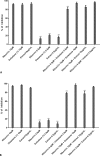In vitro Studies on The Inhibition of Replication of Zika and Chikungunya Viruses by Dolastane Isolated from Seaweed Canistrocarpus cervicornis
- PMID: 32427940
- PMCID: PMC7237426
- DOI: 10.1038/s41598-020-65357-7
In vitro Studies on The Inhibition of Replication of Zika and Chikungunya Viruses by Dolastane Isolated from Seaweed Canistrocarpus cervicornis
Abstract
The lack of vaccines and antiviral treatment, along with the increasing number of cases of Zika virus (ZIKV) and Chikungunya virus (CHIKV) infections, emphasize the need for searching for new therapeutic strategies. In this context, the marine brown seaweed Canistrocarpus cervicornis has been proved to hold great antiviral potential. Hence, the aim of this work was to evaluate the anti-ZIKV and anti-CHIKV activity of a marine dolastane isolated from brown seaweed C. cervicornis and its crude extract. Vero cells were used in antiviral assays, submitted to ZIKV and CHIKV, and treated with different concentrations of C. cervicornis extract or dolastane. The crude extract of C. cervicornis showed inhibitory activities for both ZIKV and CHIKV, with EC50 values of 3.3 μg/mL and 3.1 μg/mL, respectively. However, the isolated dolastane showed a more significant and promising inhibitory effect (EC50 = 0.95 µM for ZIKV and 1.3 µM for CHIKV) when compared to both the crude extract and ribavirin, which was used as control. Also, the dolastane showed a very potent virucidal activity against CHIKV and was able to inhibit around 90% of the virus infectivity at 10 μM. For the ZIKV, the effects were somewhat lower, although interesting, at approximately 64% in this same concentration. Further, we observed that both the extract and the dolastane were able to inhibit the replication of ZIKV and CHIKV at different times of addition post-infection, remaining efficient even if added after 8 hours post-infection, but declining soon after. A synergistic effect using sub-doses of the extract and isolates was associated with ribavirin, inhibiting above 80% replication even at the lowest concentrations. Therefore, this work has unveiled the anti-ZIKV and CHIKV potential of C. cervicornis crude extract and an isolated dolastane, which, in turn, can be used as a preventive or therapeutic strategy in the future.
Conflict of interest statement
The authors declare no competing interests.
Figures






References
Publication types
MeSH terms
Substances
LinkOut - more resources
Full Text Sources
Medical

